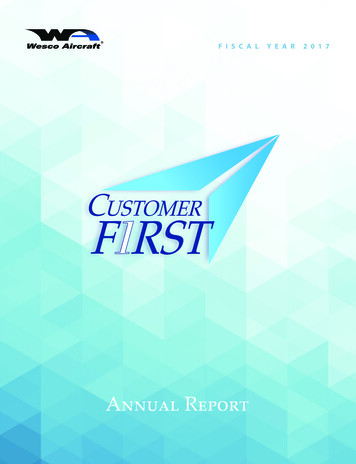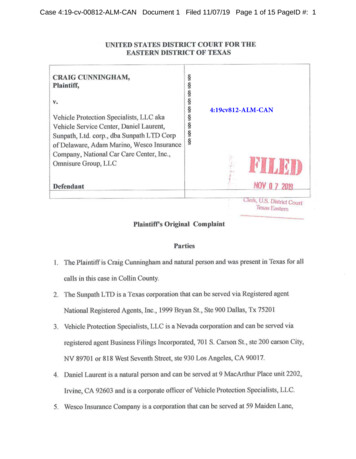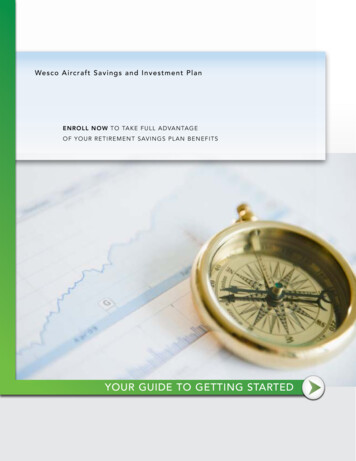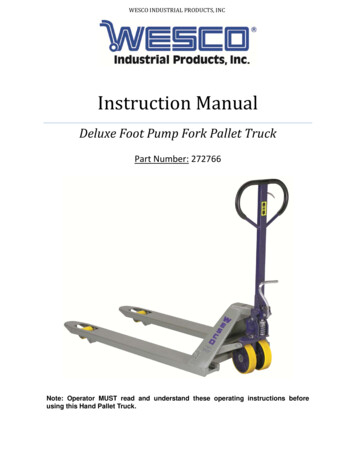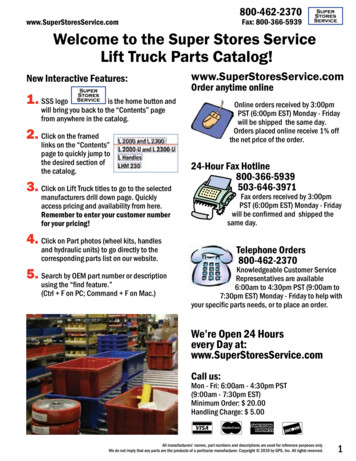
Transcription
NIM I RTPOREBusinessDevelopmentGovernment ContractingIndustry Study
SECTION ONEBusinessDevelopmentGovernment market sales were the same or higher than a year ago. At the time of theStudy, a significant majority (70%) of respondents believed that government saleswould be higher in 2020. Growth expectations remained high.The onset of the COVID-19 pandemic is likely to have substantial effects on 2020 performance. The ability to predictwhen the economy can transition back to a more normal state is uncertain. It is likely, however, that substantial stimulusdollars will make their way to the government contracting sector. This will be true not only in federal markets, but also inSLED (state, local, kindergarten through grade 12, and higher education) sectors. Typically, SLED contracts are fundedthrough federal programs and executed at the local level. This is likely to be the case with stimulus dollars as well.Limited business development resources continue to limit the agility required to compete in an environment wherefaster responses to task order vehicles are required. Contractors’ customers are also using contract vehicles with whichthey are not associated, limiting the ability to compete.Key Takeways59%challenged by limitedbusiness developmentresources46%of participants are plaguedby increased competition80%want to understandopportunity requirementssooner1The top three business developmentchallenges (“limited businessdevelopment resources,” “increasedcompetition,” and “customer usingcontract vehicles we are not associatedwith”) remain consistent with last year’sresults. However, there was a significantuptick (44% versus 34% year-over-year)in the category of “not enough timeto assemble high-quality responsesfor RFPs and RFIs.” Companies arelooking to increase investment andbetter understand requirements andopportunities earlier in the biddingprocess.Relationships are key to businessdevelopment because they facilitateidentification of opportunities andwiden the range with diverse contractvehicles. Teaming relationships shouldbe in place, rather than sought for aspecific opportunity.Overall win rates declined slightly in2019 compared to the previous year(40% versus 43% year-over-year).Large businesses had the highest winrate of 45%. Medium-sized businessesexperienced the biggest decline (35%versus 42% year-over-year), suggestinga sharper effect from increasedbusiness development challenges. Thesmall business win rate remained thesame (40% versus 41% year-over-year).Average pipeline multiples fell from5.4 to 4.5, indicating fewer contractsneeded to achieve sales objectivesand that pipeline quality should beevaluated regularly. The trend towardcontract consolidation, which drivesmore contracts to master agreements,may be misleading in evaluating pipelinemultiples.In 2019, the improvement processbegan, with medium-sized and largebusinesses adding dedicated fulltime employees to identify and targetopportunities faster. Though businessdevelopment resources continue tobe limited, the investment outlook for2020 is positive, with 58% of companiesplanning to increase resources.
Areas of Government BusinessThe breakdown between companies doing business withthe federal government and those doing business at theSLED level remained largely consistent with last year.Most companies (93%) conduct business with the federalgovernment, compared to 7% operating exclusively inthe SLED market (4% reported last year). However, 38%of companies participate in both the federal and SLEDsectors. This may be due to the fact that many contractsare bid at the federal level but executed through stateand local governments and agencies. Companies mayalso find new areas of opportunity in the SLED market ifappropriate contract vehicles are identified.Consolidation of contracts may disadvantage small andmedium-sized businesses, but mergers and acquisitions(M&A) may provide greater critical mass to succeed inchanging markets.Areas of Government Business55%38%7%FederalBoth Federaland SLEDState, Local, K-12,or Higher Ed (SLED)Revenue from Government BusinessThe percent of revenue received from government business remained consistent across all business sizes in 2019,except for a decrease for medium-sized businesses (24% versus 30% year-over-year) that corresponded with anincrease for small businesses.Revenue from Government Business28%Less than 20 million48% 20– 99.9 millionMore than 100 million24%Deltek ClarityGovernment Contracting Industry Study2
Win RateThe overall win rate in 2019 decreased slightly to anaverage of 40% compared with 43% the prior year. Thedecrease was driven by reported declines from bothmedium-sized and large businesses. Small businessesheld steady at a 40% win rate.Medium-sized businesses saw a decrease from 42%to 35% year-over-year, which may indicate increaseddifficulty operating in more fragmented and competitivemarkets.A high win rate is not the only indicator of longterm success. It could mean that a company is tooconservative in identifying opportunities, eitheridentifying too few, or a problematic method of pursuit.Win rates based on dollar value versus number ofcontracts can vary dramatically. Companies’ businessdevelopment key performance indicators (KPIs) shouldreflect their growth objectives and strategies.Average Win RateCompanies should understand both their current anddesired win rate in order to adjust business developmentstrategy appropriately. Bidding on familiar business thathas a higher probability of success should be evaluatedagainst opportunities that move up the value chain butmight be less winnable. Once decisions are reached onwhich opportunities to pursue, understanding the effectthis will have on the pipeline multiple is just as important.It is crucial to understand how often the pipeline needs toturn to generate forecasted sales.45%40%40%35%SmallLargeMediumOverallWin Rate ChangeSmallMedium12%7%Large0%26%28%Increased slightlyGovernment Contracting Industry Study10%33%40%Stayed the same17%60%9%10%38%32%20%Increased significantly14%38%11%Deltek Clarity35%28%13%Overall330%80%Decreased slightly7%100%Decreased significantly
Sales in Government MarketsIn last year’s Study, optimism reigned in the outlookfor 2019. An overwhelming percentage of respondentsexpected higher or stable government sales. Theseexpectations proved to be accurate, as revenues fromgovernment markets remained about the same in 2019.A bright outlook for 2020 carried over from 2019,with 94% of respondents looking for increased (70%) orstable (24%) sales. It is yet unknown how this outlook maybe affected by the COVID-19 pandemic.Past Year’s and Next Year’s Government Market Sales6%14%43%LowerPastYearNextYearAbout the sameHigher24%LowerAbout the sameHigher70%43%Average Revenue Generated from Top Three CustomersA high percentage of business comes from the top threecustomers. This is particularly striking in that on average,respondents indicated their largest customers wereresponsible for nearly half (47%) of their net revenue,with the second and third largest customers generatingan incremental 28% of net revenue. The good news isthat strong customer relationships lead to a stable baseof business. The potential bad news is that over-relianceon a small number of customers can be negative if thoserelationships fall apart or need to change based on theenvironment.Average Revenue Generated from Top Three geDeltek ClarityGovernment Contracting Industry Study4
Top Business Development ChallengesPerceptions of the top three business developmentchallenges remained unchanged this year, with “limitedbusiness development resources,” ranking first at59%, followed by “increased competition,” (46%) and“customer using contract vehicles we are not associatedwith,” (46%). It is interesting to note that “increasedcompetition,” slipped from 57% to 46% in the lineup ofconcerns. Importantly, there was a 10-point jump to 44%in the fourth category, “not enough time to assemblehigh-quality responses for requests for proposal (RFPs)and requests for information (RFIs).”highlight the need for more dedicated staff, tools and wellestablished business relationships that are in place beforethe opportunity presents itself. In the category of “notable to find appropriate partners,” 22% of respondentsidentified this as an important challenge, up from 19% lastyear. Inter-functional challenges within companies alsoappear to be impeding business development, with issuessuch as “need for improved sales support,” and “inabilityto effectively share company knowledge,” highlightingweaknesses that need to be addressed.With increasing adoption of task order vehicles, fastresponses are required. Companies sometimes have aslittle as two weeks to identify and bid for an opportunity,requiring a much higher level of agility. These changesTop Business Development ChallengesLimited business development resources18%Increased competition19%14%13%46%Customer using contract vehicles we are notassociated with19%15%12%46%Not enough time to assemble high-qualityresponses for RFPs and RFIs12%More restrictive spending environment 6%Not able to find appropriate partners 6%Need for improved sales support7%Inability to effectively share company knowledge 5% 4%16%9%8%7%FirstDeltek ClarityGovernment Contracting Industry Study16%27%11%10%Time-consuming forecasts and reporting 5% 3% 6%519%22%7%5%22%21%16%14%SecondThird44%59%
rem ipsumAddressing Top Business Development ChallengesThe top two initiatives cited by respondents in addressingtop business challenges center on understandingthe requirements of opportunities faster (80%) anddeveloping effective mechanisms to find and identifybetter quality opportunities (78%). The third most-citedway to address business development challenges was“expansion into other government agencies outsideexisting customer bases,” (75%).The fourth highest response, “more or better teamingand partnering methods or approach,” went up from 61%to 70% year-over-year. New tasking vehicles are requiringextremely fast responses from companies. Teamingpartner relationships must already be establishedif a company wants to compete. Agility in businessdevelopment is a trend that is becoming increasinglyimportant.The pandemic may cause temporary disruption inthe market, which may benefit some contractors andnegatively affect others. The stimulus dollars that reachthe industry will have differing impacts based on thegovernment’s prioritization.Addressing Top Business Development ChallengesBetter understanding of opportunities and theirrequirements earlier in the processMore or better opportunity identification37%Expanding into other government agenciesoutside of our existing client baseMore or better teaming and partneringmethods or approachImproved sales process and/or systems toimprove effectiveness20%More or better GWAC, IDIQ, and/or multi-awardcontract managementNew tools or systems to improve Acquisition of partners, competitors, and/orother firms14%29%43%19%Most important63%39%Improved analytics and/or understanding ofthe sales processExploration of new markets outside ofgovernment market70%49%25%20%75%35%21%Improved use of existing company knowledgeand materials78%41%40%Increasing staffing to support sales andbusiness development80%31%49%40%21%Important* (such as proposal creation, reporting, and CRM automation)Deltek ClarityGovernment Contracting Industry Study6
New Opportunities IdentificationThe top sources of new opportunities are “activecustomer relationships,” “teaming partners andnetworking,” and “Requests for Proposals/Requestsfor Qualifications.” Only 33% of opportunities were“marketing-generated leads,” which rated lower than“website searches,” (42%). “Business development staff”accounted for 71% of new opportunity identification,which implies a high rate of return on investment indedicated staff.Sources to Identify New Opportunities83%Active client relationshipsTeaming partners/networking77%Requests for Proposals/Requests for Qualifications77%Public bid notices such as SAM.gov73%Business Development staff71%68%Industry conferences and eventsMarket Intelligence Databases (e.g., GovWin IQ)66%Staff-identified leads65%Website searchesMarketing-generated leads7Deltek ClarityGovernment Contracting Industry Study42%33%
Top Criteria for Sourcing and Selecting Teaming PartnersThe top three criteria for sourcing and selecting teamingpartners are “past performance/experience,” (73%,unchanged), “capabilities,” (63%, down from 73%) and“customer relationship,” (55% up from 47% last year).“Company reputation/stability,” is rated at 44%, or fourth,in terms of importance in the selection process.The existence of partnerships with proven capabilities isimportant in an atmosphere of speed accompanied byprice sensitivity. While rated toward the bottom, the needfor culture consistency should not be underestimated.When there is cultural consistency, teams typicallywork faster and more efficiently. Achieving these typesof relationships may be a particular challenge for smallbusinesses with limited resources.Top Criteria for Sourcing and Selecting Teaming PartnersPast performance/experience22%Capabilities29%Customer relationship21%15%7%Cost 3% 4%Cultural fit 5% 17%19%Company reputation/stabilitySocioeconomic status30%19%SecondThirdDeltek ClarityGovernment Contracting Industry Study8
Expected Investment in Business DevelopmentDespite the clear need for upgrading dedicated businessdevelopment staff and tools, only 58% of companies planto increase their existing level of investment in businessdevelopment. Sixty-six percent (66%) of medium-sizedbusinesses expect an increase. Interestingly, manycompanies still rely on generic tools, such as MicrosoftExcel, rather than specialized products, to manage theirbusiness development activities.Expected Investment in Business DevelopmentSmall51%47%66%MediumLarge62%0%20%Deltek Clarity40%40%IncreaseGovernment Contracting Industry Study3%37%58%Overall931%Stay the same60%80%Decrease100%
CLARITY OUTLOOKBusinessDevelopmentThe COVID-19 pandemic significantly clouds the outlook for 2020. It is unknown howmuch this will stretch out procurement and contract awards. It is also unknown towhat extent this may impact revenue recognition as some contracts temporarily slow.How companies behave during this period will determine how well they bear the bruntof the economic downturn.Before the pandemic, government contractors exited2019 with a rosy outlook for 2020, with an expectation ofcontinued revenue growth and strong profit margins. Thetop five markets in which respondents expected growthinclude federal, IT, professional services, aerospace anddefense, and SLED.Download the full report at:Early identification of opportunities improves theability to win, as do strong customer relationshipsand diversification of the business portfolio. Thesecapabilities will be particularly important in the currentuncertain business environment. The ability to quicklyidentify opportunities and respond fast will separatethe successful companies from those that can’t movebeyond their current market position.deltek.com/Clarity-GovConDeltek ClarityGovernment Contracting Industry Study10
For more than 35 years, Deltek has offered unique solutions tailored for the needs of thegovernment contracting industry. Deltek customers include 98 of the Top 100 GovernmentContractors, and our clients use our solutions to: Track thousands of federal, state and local contracting opportunitiesLeverage actionable intelligence on market trendsImprove contract win and retention ratesComplete projects on time and under budgetEnsure project, information technology and corporate governanceStreamline the financial management of their organizations.Deltek forGovernmentContractorsLearn more about the Deltek Clarity Government ContractingIndustry Study at deltek.com/clarity-govcon11Deltek ClarityGovernment Contracting Industry Study
Better software means better projects. Deltek is the leading global provider ofenterprise software and information solutions for project-based businesses.More than 30,000 organizations and millions of users in over 80 countriesaround the world rely on Deltek for superior levels of project intelligence,management and collaboration. Our industry-focused expertise powersproject success by helping firms achieve performance that maximizesproductivity and revenue. Deltek, Inc. All rights reserved.All referenced trademarks are the property of their respective owners.deltek.comDeltek Clarityinfo@deltek.com800.456.2009Government Contracting Industry Study12
Deltek Clarity Government Contracting Industry Study 2 SECTION ONE Business Development Government market sales were the same or higher than a year ago. At the time of the Study, a significant majority (70%) of respondents believed that government sales would be higher in 2020. Growth expectations remained high. Areas of Government Business
